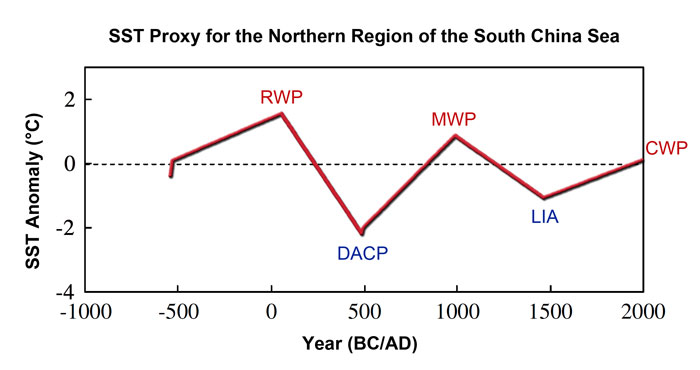| 2 Science">Tweet | Follow @co2science |
Paper Reviewed
Yan, H., Soon, W. and Wang, Y. 2015. A composite sea surface temperature record of the northern South China Sea for the past 2500 years: A unique look into seasonality and seasonal climate changes during warm and cold periods. Earth-Science Reviews 141: 122-135.
In this intriguing paper, Yan et al. (2015) describe how they developed a new record of the sea surface temperature (SST) variation in the northern South China Sea (SCS) during the late Holocene by combining seven seasonally-resolved coral and Tridacna gigas (giant clam) Sr/Ca-based SST time-windows with the instrumental-derived SST record of the modern interval of AD 1990 to 2000.
These procedures led to their determining that the SSTs of 80-year warm-period time-windows centered on AD 990 and AD 50 were 0.89°C and 1.55°C higher than those of the instrumental period of AD 1990-2000 (see Figure 1 below). And they further note, in this regard, that the pre-instrumental warmer SSTs in the northern SCS centered on AD 990 and AD 40 "occurred within the notable warm episodes of the Medieval Warm Period and Roman Warm Period."
These findings thus demonstrate, yet again - and contrary to the contentions of the world's climate alarmists - that there is nothing unusual, unnatural or unprecedented about the current value of the flat-lining temperature of the globe over the past 18 years, which is significantly lower than the levels of warmth that held sway throughout the world during portions of both the Medieval and Roman Warm Periods of the past.

Proxy sea surface temperatures in the northern South China Sea revealing warmer temperatures than present during Medieval (MWP) and Roman (RWP) times, and cooler than present temperatures during the Dark Ages Cold Period (DACP) and Little Ice Age (LIA). Adapted from Yan et al. (2015).




